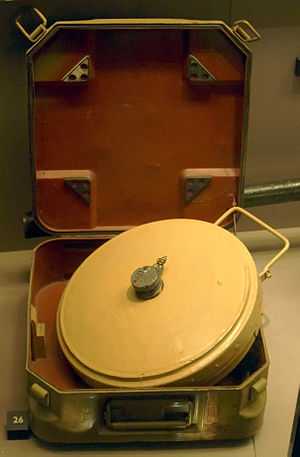Tellermine 35

The Tellermine 35 (T.Mi.35) was a German metal-cased anti-tank mine used extensively during the Second World War. The mine's case is made of sheet steel, and has a slightly convex pressure plate on the top surface with a central fuze well. Two secondary fuze wells are located on the side and bottom of the mine for anti-handling devices.
For use on beaches and underwater the mine could be deployed inside a specially designed earthenware or concrete pot, which acted as a waterproof jacket for the mine.
A later variant of the mine, the T.Mi.35 (S) was produced with a ribbed case and a fuze cover. The ribbed case stopped sand from blowing off the top of the mine when it was used in a desert or sandy environment.
Pressure of 400 pounds (180 kg) on the center of the mine or 200 pounds (90 kg) on its edge deforms the pressure plate compressing a spring, and breaking a shear pin which holds back the spring-loaded striker. Once the striker is released it flips downwards into a percussion cap which fires the adjacent detonator followed by the booster charge and then the main explosive filling of TNT.
Specifications
- Height: 76 mm
- Diameter: 318 mm
- Weight: 9.1 kg
- Explosive content: 5.5 kg of TNT
- Trigger weight: 90 to 180 kg
References
- Jane's Mines and Mine Clearance 2005-2006
- TM 5-223, Foreign Mine Warfare Equipment
- TM-E 30-451, Handbook on German Military Forces, March 1945
| ||||||||||